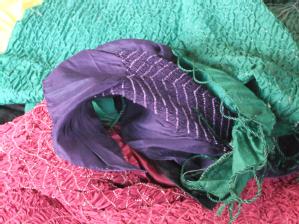Jabbar Khatri

Occupation: bandhani producer and wholesaler
Education: Graduate
Place of residence: Bhuj
Date of interview: 20/2/2012
Interview Summary
Jabbar Khatri is a dynamic bandhani producer, wholesaler and supplier who works transnationally. Jabbar started taking an interest in bandhani when he was just thirteen. He had seen his mother and sisters tying for others and that particular background helped him learn the craft. Eighteen years ago, he started an enterprise with his elder brother Abdulla. Once he started the bandhani-making business there was no looking back and he has had nearly twenty years of success. The business started small, making cotton dupatta and saree mainly for the local market, and both the brothers had other jobs at the same time as developing the bandhani venture. Gradually, he expanded the small enterprise and switched from concentrating on the Kachchhi market to the national level. He supplied his products markets in Delhi, Mumbai and Ahmadabad for around eight years.
The turning point in his career came just before the earthquake in 2000, when he first attended a NID (National Institute of Design, Ahmadabad) sponsored workshop held at the Khatri community hall near his house. After the earthquake of 2001, he attended an NID workshop organised by Siburi work. These workshops helped him to learn innovative methods and they encouraged his enterprise to take a new direction. Thereafter, Jabbar attended the NID workshop every year for five years. This helped him to further develop his contacts with designers at a national level. One such contact, with Rafique, further changed the course of his business. This diploma student approached him to make bandhani for an American company DOSA. From this point, Jabbar entered the global market. In the meanwhile, from 2002, he began to make new products: silk dupatta, scarves and stoles. In addition, his father’s tourist groups began to take interest in his work. Their visits increased the interaction and contact with foreign clientele. Jabbar also started to work on designs provided by these tourists.
Displaying his creations at the Lakme Fashion week in 2007, for the designers Rahul and Firdaus, was another event that changed the style of his bandhani collection. One success led to another, and each year thereafter he made bandhani garments for high-profile Indian designers. In 2008-09, with Amit/Anit Arora and in 2009-10 with Tarun Thailiyani, Jabbar displayed his work at the fashion shows. He also worked with designers Neeru Kumar and Rajesh Pratap Singh. The positive response he received from these connections inspired him to be further open new ventures and risk taking. His ‘trial and error’ philosophy also helped him to introduce innovative designs, although this is also a challenging way of working. In 2006, the NGO Khamir informed him about the UNESCO Seal of Excellence and both that year and the following year he received a UNESCO certificate. In 2008, his brother Abdulla received the same Excellence seal. In 2007, through Warwick University’s Global History Centre he came in contact with Britain. Fashion and textile scholar Eiluned Edwards visited him and liked his work and consequently invited Jabbar to the V&A to exhibit his collection. After Europe, he next turned to the US. His work was selected to be shown at the Santa Fe folk art market: he thus entered the US market for the first time in 2007. Jabbar then visited Santa Fe for the next four years. In the meanwhile, he participated in a programme at Paris and in 2011 visited Dallas, Texas.
A mixture of hard work and, in Jabbar’s words ‘kismat’, destiny, is behind the impressive growth of his business. Feedback on his collections inspired him to create new and more distinctive products. His eye for colour and focus on the very finest bandhani workinspired him to discover new and ever more vibrant styles. His interest in fashion designing helped to expand the range of his collections.
For the financial aspects of the business, his father’s banking background came in handy. However, his family has not been involved in bandhani-making for the last five generations; it was Jabbar's own curiosity about his community's craft that drove the revival of the craft and took it to a new level.
Jabbar’s working day begins at 10 in the morning. His workers leave work at 7 in the evening but, Jabbar continues to work until 9 o’clock, and checks and responds to all the emails. He coordinates all the different tasks of his team of workers. Regarding his future plans, Jabbar told us that he earnestly wishes to keep improving his production. He told us he was never pressurised by his father to follow a particular career, and similarly, Jabbar doesn’t expect his own son to take up the enterprise when he is older.
